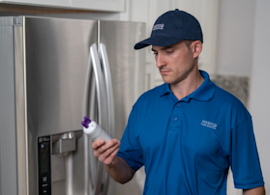How to keep a washer odor free


A lot of dirt, soap, lint, softener and water pass through your washing machine. Over time, they form a residue where odor-causing bacteria and other microorganisms can grow. These steps can get rid of washer odor and keep it from coming back.
For more about troubleshooting and repairing washing machine problems, see our washer DIY repair help.
Let the washer air out
One of the best things you can do to prevent odors is to remove wet clothes as soon as possible when the load is done. Then leave the washer open so the interior can dry.
Clean the washer once a month
To keep your washer clean and free of odors, run an empty load using hot water and Affresh Washing Machine Cleaner once a month. The cleaner removes odor-causing debris and detergent buildup in the washer. Simply wipe away any residue left behind after the cycle ends.
No Affresh on hand? :Pour 2 cups of bleach in the detergent dispenser and then run an empty hot-water load. Run another empty load afterwards to rinse away any lingering bleach.
If you'd rather not use bleach, two common household ingredients—white vinegar and baking soda—do the trick. The vinegar disinfects like bleach, but it's milder. Its acidity also helps dissolve soap residue in the wash tub. Baking soda cleans soap scum and helps remove odors.
Steps for a top-load washer:
Start an empty load with hot water and 3 to 4 cups of white vinegar.
Let the washer run a few minutes, then add about 1/2 cup of baking soda.
Run the washer again for a few minutes to mix in the baking soda, then stop the washer and allow it to sit for 30 minutes to an hour. Then resume the cycle and let it finish.
Run a second hot wash cycle to clean out gunk loosened by the vinegar water.
Steps for a front-load washer:
Run an empty load using hot water and 2 cups of vinegar added to the detergent dispenser.
Run a second complete cycle after adding 1/2 cup baking soda to the drum.
Hand-clean washer nooks
Clean around the lid or door weekly using a soft cloth dipped in warm water and sprinkled with a non-abrasive cleaner. Use a toothbrush if necessary to clean grime from dispensers. A toothbrush also can come in handy to clean mold and mildew from the gasket around the door of a front-load washer.
Wipe off hard water deposits
Milky white stains are a sign of hard-water deposits, which attract soap scum that can lead to mold and mildew. Wipe off hard-water stains with vinegar or a washer-safe cleaner.
Check the trap, if there is one
If your front-load washer has a pump with a trap area, check your washing machine’s owner’s manual for instructions on how to clean it. Lint or other items stuck in the trap area can get smelly.
For more articles and videos on washer troubleshooting and repair guides, see our washer repair help section.
Most common symptoms to help you fix your washers
Choose a symptom to see related washer repairs.
Main causes: clogged drain hose, house drain clogged, bad drain pump, water-level pressure switch failure, bad control b…
Main causes: worn agitator dogs, bad clutch, broken motor coupler, shifter assembly failure, broken door lock, suspensio…
Main causes: bad lid switch or door lock, bad timer or electronic control board, wiring failure, bad water inlet valve a…
Main causes: broken lid switch or lid lock, bad pressure switch, broken shifter assembly, faulty control system…
Main causes: unbalanced load, loose spanner nut, worn drive block, broken shock absorber or suspension spring, debris in…
Main causes: no water supply, bad water valves, water-level pressure switch failure, control system failure, bad door lo…
Main causes: lack of electrical power, wiring failure, bad power cord, electronic control board failure, bad user interf…
Main causes: leaky water inlet valve, faulty water-level pressure switch, bad electronic control board…
Main causes: water heater failure, bad water temperature switch, faulty control board, bad water valve, faulty water tem…
Most common repair guides to help fix your washers
Effective articles & videos to help repair your washers
Use the advice and tips in these articles and videos to get the most out of your washer.

Find tips for using your washing machine efficiently to save energy and help reduce utility bills.…

Learn about all the convenient features on our Sears PartsDirect website that make your parts purchases easier.…

Get answers to frequently asked questions about Sears and Sears PartsDirect.…
